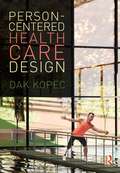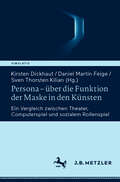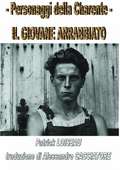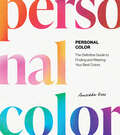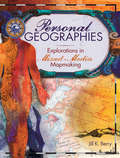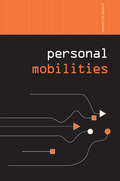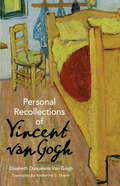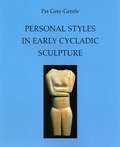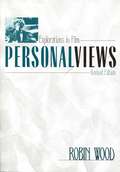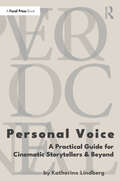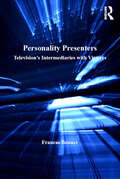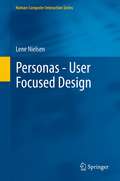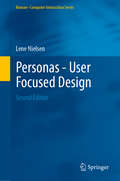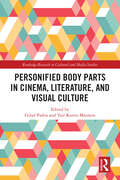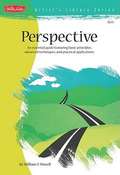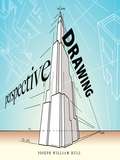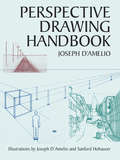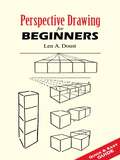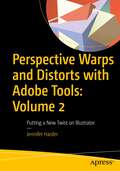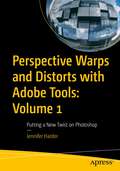- Table View
- List View
Person-Centered Health Care Design
by Dak KopecDisease, injury, or congenital disorders result in an inability to perform activities of daily living as effectively as others. Most of these activities take place within and are dependent upon the designed environment. This book presents the specialized area of person-centered health care design, which focuses on a person's design needs because of one or more health conditions and requires foundational knowledge pertaining to infection control, bio-physiology, neuroscience, and basic biomechanics. Whether the designer has engaged in person- or condition-centered design, this book examines the causes that bring about health conditions, such as autoimmune disorders, chronic lung disease, muscular dystrophy, and neurological disorders, and the effects these have on a person's quality of life. Over forty various heath conditions are discussed in relation to assorted building typologies—schools, group homes, rehabilitation and habilitation centers, and more—to identify design solutions for modifying each environment to best accommodate and support a person’s needs. Dak Kopec encourages readers to think critically and deductively about numerous health conditions and how to best design for them. This book provides students and practitioners a foundational framework that supports the promotion of health, safety, and welfare as they pertain to a person's physiological, psychological, and sociological well-being.
Persona – über die Funktion der Maske in den Künsten: Ein Vergleich zwischen Theater, Computerspiel und sozialem Rollenspiel (Simulatio. Theatertechniken in Literatur, Medien und Wissenschaft)
by Daniel Martin Feige Kirsten Dickhaut Sven Thorsten KilianDer Sammelband thematisiert Masken und Maskierungen. Im Vergleich der Künste untersucht er die funktionale Verwendung dieses Theaterrequisits, das eine Technik impliziert, und die Ausgestaltungen von Persona in den Künsten, Maskenverwendungen, -gestaltungen und -problematisierungen, die stets die Produktion von Fiktion und/oder Simulation reflektieren. Zehn Beiträge analysieren Beispiele seit dem 18. Jahrhundert der bildenden Kunst, des Digitalen, des Computerspiels, des Theaters, der erzählenden Literatur und der sozialen Rolle, die jeweils die Maske als Fiktions- oder Simulationsgenerator verstehen, thematisieren und kulturell vergleichend beschreiben. Pirandello stellt dabei grundsätzlich einen wichtigen, aber nicht den einzigen Referenzpunkt dar.
Personaggi della Charente: IL GIOVANE ARRABBIATO
by Patrick LoiseauLe jeune homme en colère, a cui, nel presente lavoro, è stato dato il titolo italiano non ufficiale “Il giovane arrabbiato”, è il racconto di un’indagine su una foto che ha affascinato Michel Boujut (1940-2011) scrittore e produttore televisivo, e lo ha spinto ad andare alla ricerca del soggetto quarantasei anni dopo l’esecuzione dello scatto che ha prodotto un’immagine tra le più famose al mondo. Patrick Loiseau, eseguendo un lavoro di ricerca durante il corso di Laurea Magistrale in Lettere Moderne presso l’Université de Rennes 2, ripercorre la stessa esistenza del libro di Boujut e si pone l’obiettivo di farcelo scoprire, sentire e vedere dalla prospettiva di una discussione continua.
Personal Color: The Definitive Guide to Finding and Wearing Your Best Colors
by Anuschka ReesThe definitive modern guide to finding your season and best colors, from the author of The Curated Closet.Why do some colors look radiant and effortless on one person but completely wash out another? The answer is color theory. In Personal Color, you&’ll harness the power of color theory to identify your color season and discover which shades best harmonize with your unique skin tone, hair, and eye color to make your natural beauty shine. In Personal Color you will learn how to:Accurately predict whether any color will suit you (or not)Find your color season (spring, summer, autumn, or winter) and subtype (clear, true, light, soft, or deep)Broaden your &“color horizon&” to go beyond neutrals and shades that are considered on-trend or safeAccurately assess photos and color descriptions when shopping onlineWear colors you love that are not in your seasonal palettePick the makeup and hair colors that work best for youFeaturing step-by-step instructions to identify your personal color palette, hundreds of color swatches, and example photos of models of all races, genders, and ages representing the color seasons, Personal Color is a timeless resource full of exercises, charts, cheat sheets, and glossaries that you&’ll find yourself reaching for again and again.
Personal Comfort Systems for Improving Indoor Thermal Comfort and Air Quality (Indoor Environment and Sustainable Building)
by Bin Yang Faming Wang Maohui Luo Qihong DengThis book first describes fundamental knowledge on human thermal comfort, adaptive thermal comfort, thermal comfort in sleeping environments, modeling of human thermal comfort, and thermal comfort assessment using human trials. Next, it presents an in-depth review of concept progress and evaluation of various personal comfort system, summarizes important findings and feasible applications, current gaps as well as future research needs. The seven chapters included in this section are task/ambient conditioning systems, personalized ventilation systems, electric fans, personal comfort systems, thermoelectric systems, personal thermal management systems, and wearable personal thermal comfort systems. This book provides valuable guidance for personal comfort system design and further improvement on the personal comfort performance. It will be a valuable resource for academic researchers, engineers in industry, and government regulators in the field of sustainable buildings and built environment.
Personal Geographies: Explorations in Mixed-Media Mapmaking
by Jill K. BerryExplore your Creative Self with Mixed-media MapsYou don't have to be a world traveler or a professional cartographer to embark on a grand journey of self-discovery through mapmaking. Personal Geographies gives you the tools and techniques you'll need to create artful maps of your self, your experiences and your personal journey. Chart the innermost workings of your mind, document your artistic path and create an unfolding maze of your future dreams and goals. Inside Personal Geographies you'll discover: 21 mixed-media map projects featuring artistic techniques like working with alcohol inks and pochoir, painting on a black surface and carving custom stamps Insight into the world of traditional and contemporary maps and how they relate to and inspire personal mapmaking A gallery of maps by contributors from around the world to spark your own creativity From mapping your head, hands and heart to recording powerful memories or experiences, the maps in Personal Geographies are a gateway into the fascinating and meaningful world of you.
Personal Mobilities (Networked Cities Ser.)
by Aharon KellermanPersonal Mobilities provides a systematic study of personal movement focusing on the dimensions of space, individuals, societies and technologies. Kellerman examines a variety of personal mobilities, including air transportation, through several perspectives, examining the human need for movement, their anchoring within wider societal trends, commonalities and differences among mobility technologies and international differences. Although spatial mobility seems geographical by its very nature, the topic has been so far treated only partially, and mainly by sociologists. Personal Mobilities highlights geographical as well as sociological aspects and is the first book to focus solely on personal mobilities.
Personal Recollections of Vincent Van Gogh
by Elisabeth Duqesne Van Gogh Katherine S. DreierRejected in their day by painters, critics, and collectors, the visions of Vincent Van Gogh now rank among the most beloved and influential works in the history of Western art. The artist sold only a single painting in his lifetime, despite an abundant oeuvre of more than 2,000 artworks. Today his paintings fetch tens of millions at auction, and visitors from around the world flock to Amsterdam's Van Gogh Museum. The artist's life of grinding poverty, his severe mental illness, and the derision of his contemporaries combined to form a romantic ideal of the tortured artist. Twenty-three years after Van Gogh's suicide, in the wake of his slowly growing fame, the painter's sister published this memoir. An intimate view of the artist's life, art, and philosophy, the book is illustrated with reproductions of several of Van Gogh's most characteristic works, including portraits and landscapes.
Personal Styles in Early Cycladic Sculpture
by Pat Getz-GentlePat Getz-Gentle provides a clear and detailed survey of the Cycladic period, an early Bronze Age culture that thrived at the heart of the Aegean. In particular, she emphasizes the steps leading to the iconic, reclining folded-arm figure that uniquely defines the Cycladic era. Getz-Gentle also focuses on the personal aesthetics of fifteen carvers, several of whom are identified and discussed in this volume. New to this paperback edition is an expanded bibliography as well an addendum that contains additional works Getz-Gentle has attributed to some of the fifteen Cycladic sculptors she discusses in her book.
Personal Views: Explorations in Film
by Robin WoodRobin Wood, the renowned scholarly critic and writer on film, has prepared a new introduction and added three essays to his classic text Personal Views. This important book contains essays on a wide range of films and filmmakers and considers questions of the nature of film criticism and the critic. Wood, the proud "unreconstructed humanist," offers in this collection persuasive arguments for the importance of art, creativity, and personal response and also demonstrates these values in his analyses. Personal Views is the only book on cinema by Wood never to have been published in the United States. It contains essays on popular Hollywood directors such as Howard Hawks, Vincente Minnelli, and Leo McCarey; as well as pieces on recognized auteurs like Max Ophuls, Orson Welles, Fritz Lang, and Josef von Sternberg; and essays on art-film icons Jean-Luc Godard, Michelangelo Antonioni, and Kenji Mizoguchi. The writings that make up Personal Views appeared duing a pivotal time in both film studies-during its academic institutionalization-and in the author's life. Throughout this period of change, Wood remained a stalwart anchor of the critical discipline, using theory without being used by it and always staying attentive to textual detail. Wood's overall critical project is to combine aesthetics and ideology in understanding films for the ultimate goal of enriching our lives individually and together. This is a major work to be read and reread not just by film scholars and students of film but by anyone with an interest in twentieth-century culture.
Personal Voice: A Practical Guide for Cinematic Storytellers and Beyond
by Katherine LindbergOffering a definitive approach by which any individual may learn to unleash the power of the personal, this book provides the reader with an exhaustive guide on how to tell the stories they’re uniquely qualified to tell.Anchored in process and skills acquisition, this book shifts the paradigm for all storytellers—seasoned and emerging—as it empowers them to increase their creative and business acumen. Guiding Creatives in recognizing the vital role of personal voice in their work, the book illuminates the process by which to discern and harness that voice, proffers the tools to incorporate voice into stories that resonate with audiences, and examines how voice translates to best industry practices in merging creative and business development. Unfolding in three parts, the chapters include practical exercises and mentor-like strategies to help transfer practice to industry. The text concludes with a revealing interview with a film industry expert, who sheds light on the knowledge and tools needed to thrive in an ever-evolving marketplace.This is the ideal guide for professionals and students alike, appealing to aspiring film and TV writers specifically.
Personality Presenters: Television's Intermediaries with Viewers
by Frances BonnerTelevision presenters are key to the sociability of the medium, speaking directly to viewers as intermediaries between audiences and those who are interviewed, perform or compete on screen. As targets of both great affection and derision from viewers and the subjects of radio, internet, magazine and newspaper coverage, many have careers that have lasted almost as long as post-war television itself. Nevertheless, as a profession, television presenting has received little scholarly attention. Personality Presenters explores the role of the television presenter, analysing the distinct skills possessed by different categories of host and the expectations and difficulties that exist with regard to the promotion of the various films, books, consumer and cultural products with which they are associated. The close involvement of presenters with the content that they present is examined, while the impact of the presenters' own celebrity on the tasks that they perform is scrutinised. With a focus on non-fiction entertainment shows such as game shows, lifestyle and reality shows, chat, daytime and talk shows, this book explores issues of consumer culture, advertising and celebrity, as well as the connection of presenters with ethical issues. Offering detailed case studies of internationally recognised presenters, as well comparisons between national presenters from the UK and Australia, Personality Presenters provides a rich discussion of television presenters as significant conduits in the movement of ideas. As such, it will appeal to sociologists as well as those working in the fields of popular culture, cultural and media studies and cultural theory.
Personalmanagement in Zeiten des Fachkräftemangels: Schnelleinstieg für Architekten und Bauingenieure (essentials)
by Dietmar GoldammerAufgrund des Wandels in unserer Gesellschaft wird es Veränderungen in den Unternehmen geben, die auch vor den Planungsbüros nicht haltmachen. Dieser Wandel betrifft auch das Personalmanagement. Der Autor gibt Tipps, wie man sich dabei in Zukunft aufstellen könnte.Der Autor:Dr. Dietmar Goldammer ist Diplom-Kaufmann und Unternehmensberater für Architekten und Ingenieure. Er gibt als Dozent Seminare zur Betriebswirtschaft für Planer und ist Fachbuchautor zahlreicher Publikationen zum Thema Betriebswirtschaft. Er ist Vorstandsmitglied der Praxisinitiative erfolgreiches Planungsbüro (PeP) in Berlin.
Personas - User Focused Design
by Lene NielsenPeople relate to other people, not to simplified types or segments. This is the concept that underpins this book. Personas, a user centered design methodology covers topics from interaction design within IT, through to issues surrounding product design, communication, and marketing. Project developers need to understand how users approach their products from the product's infancy, and regardless of what the product might be. Developers should be able to describe the user of the product via vivid depictions, as if they - with their different attitudes, desires and habits - were already using the product. In doing so they can more clearly formulate how to turn the product's potential into reality. With contributions from professionals from Australia, Brazil, Finland, Japan, Russia, and the UK presenting real-world examples of persona method, this book will provide readers with valuable insights into this exciting research area. The inspiration to create user descriptions includes character-driven narratives, and the film Thelma & Louise is analyzed in order to understand how the development process can also be an engaging story in various professional contexts. With a solid foundation in her own research at the IT University of Copenhagen and more than five years of experience in solving problems for businesses, Lene Nielsen is Denmark's leading expert in the persona method. She has a PhD in personas and scenarios, and through her research and practical experiences she has developed her own approach to the method - 10 Steps to Personas. Personas - User Focused Design presents a step-by-step methodology of personas which will be of interest to developers of IT, communications solutions and innovative products.
Personas - User Focused Design: User Focused Design (Human–Computer Interaction Series #15)
by Lene NielsenPeople relate to other people, not to simplified types or segments. This is the concept that underpins this book. Personas, a user centered design methodology, covers topics from interaction design within IT, through to issues surrounding product design, communication, and marketing. Project developers need to understand how users approach their products from the product’s infancy, and regardless of what the product might be. Developers should be able to describe the user of the product via vivid depictions, as if they – with their different attitudes, desires and habits – were already using the product. In doing so they can more clearly formulate how to turn the product's potential into reality. Based on 20 years’ experience in solving problems for businesses and 15 years of research, currently at the IT University of Copenhagen, Lene Nielsen is Denmark’s leading expert in the persona method. She has a PhD in personas and scenarios, and through her research and practical experiences has developed her own approach to the method – 10 Steps to Personas. This second edition of Personas – User Focused Design presents a step-by-step methodology of personas which will be of interest to developers of IT, communications solutions and innovative products. This book also includes three new chapters and considerable expansion on the material in the first edition.
Personen beschreiben, Leben erzählen: Die Fernsehporträts von Georg Stefan Troller und Hans-Dieter Grabe
by Christian HißnauerDas jeweils einzigartige Œuvre von Georg Stefan Troller und Hans-Dieter Grabe wird hier erstmals werk- und fernsehhistorisch umfassend analysiert. Ausführlich werden die dokumentarischen Methoden dieser wichtigen Wegbereiter des deutschen Fernsehdokumentarismus erläutert und ihre dramaturgischen und ästhetischen Konzepte beschrieben.
Personified Body Parts in Cinema, Literature, and Visual Culture (Routledge Research in Cultural and Media Studies)
by Gilad Padva Yair Koren-MaimonPersonified Body Parts in Cinema, Literature, and Visual Culture investigates the power of personifying body parts in cinema, television, visual culture, literature, erotica, folklore, and mystique.Culturally, socially, and poetically exposing hidden aspects and subtleties of human existentialism, this book vigorously questions and problematizes numerous artistic, aesthetic, technological, naïve, and macabre manipulations of body parts for various purposes. A diverse team of authors explore how scribing human traits to limbs, eyes, brains, genitalia, hearts, and other inner organs is grotesque and aesthetic, repealing and appealing, intimidating and intimate, rude and enjoyable, material and spiritual, surprising and mundane. Personified organs are interrelated with bodily integrity, visceral aesthetics, distorted nature, social anxiety and acceptability, cultural classifications and hierarchies, and dissident innovativeness andradicalism.This interdisciplinary volume involves body studies; cinema, television, and media studies; literature studies; cultural, intercultural, and countercultural studies; mythology and folklore studies; gender, sexuality, trans and queer studies; ethnicities and postcolonialism; and art history.
Perspectivas mizrahitas para a sociedade israelita e judaica.
by Mati ShemoelofArtstas e autores israelitas estão começando a criar uma cultura hebriaca alternativa que desafia normas e frontiras nacionais.
Perspective (Artist's Library Book #13)
by William PowellWhether you specialize in drawing—even cartooning and animationùor prefer media such as acrylic, oil, pastel, or watercolor, a good knowledge of perspective is invaluable. It is the foundation of all great paintings and drawings, no matter what medium. Perspective shows you everything you need to know to make objects look three dimensional. Practice the methods of measuring and dividing areas proportionately; then learn how we perceive depth and distance, and how to render it correctly on paper or canvas. You will learn the basics and beyond, covering concepts like foreshortening; cast shadows; reflections; and even one-, two-, and three-point perspective. And once you have a good grasp of the basics, it's easy to graduate to more complex and irregular forms. This comprehensive guide will show you how!
Perspective Drawing
by Joseph William HullThis richly illustrated guide to perspective drawing features 17 reproductions of ancient and modern art, plus more than 200 instructive figures. The first half encourages freehand drawing, cultivating practical exposure to the principles of perspective. The second part addresses the laws and theories that constitute the science of perspective.Encouraging students to begin immediately with pencil drawings, the first part examines the application of perspective to depicting light and shade, textured objects, and imaginary as well as existing forms. The second part deals exclusively with rules of perspective, covering a wide scope and explaining the mechanics of perspective thoroughly and yet simply. Intended as an auxiliary to the first half's drawing instructions, part two is organized for ready reference as students progress through part one.
Perspective Drawing Handbook (Dover Art Instruction Ser.)
by Joseph D'AmelioThis handy guide provides numerous insights and shortcuts to drawing and sketching effectively. Describing mandatory skills for beginning and advanced students, the text covers such subjects as diminution, foreshortening, convergence, shade and shadow, and other visual principles of perspective drawing.Accompanying a concise and thoughtfully written text are more than 150 simply drawn illustrations that depict a sense of space and depth, demonstrate vanishing points and eye level, and explain such concepts as appearance versus reality; perspective distortion; determining heights, depths, and widths; and the use of circles, cylinders, and cones.Artists, architects, designers, and engineers will find this book invaluable in creating works with convincing perspective.
Perspective Drawing for Beginners
by Len A. DoustThe amateur artist faces many challenges. To Len A. Doust, perspective is by far the most problematic. With his trademark humor, the author/artist turns his expert eye toward that "dreaded, horrid word." In a clearly written how-to guide on mastering the art of perspective, he carefully:* describes the roles of lines, boxes, and circles* provides shortcuts for visualizing shapes and forms* incorporates thirty-three plates of helpful illustrationsOne of the most concise introductions available for beginners, this practical volume will be an important addition to any artist's resource library.
Perspective Made Easy (Dover Art Instruction Ser.)
by Ernest R. NorlingPerspective, the author tells us, is easy; yet surprisingly few artists are aware of the simple rules that make it so. This easy-to-follow book -- the first devoted entirely to clarifying the laws of perspective -- remedies the situation. In it, the author uses over 250 simple line drawings to illustrate the concepts involved.Beginning with clear, concise, immediately applicable discussions of the horizon, vanishing point, and the crucial relationship of eye level to perspective drawing, you'll learn how to place figures and objects in a drawing, depict interiors, create shade and shadows, and achieve all the other elements necessary for a successful perspective drawing. By repeatedly stressing important points, Mr. Norling teaches you to make them second-nature. Moreover, his approach is so simple and direct that no matter how little raw talent or experience you have, you will soon be able to apply these techniques almost instinctively.Mastery of perspective is a basic skill every artist must have. This simple, nontechnical guide will enable you to master its essentials in a relatively short time. Clear and concise, this book is an essential addition to any artist's bookshelf.
Perspective Warps and Distorts with Adobe Tools: Putting a New Twist on Illustrator
by Jennifer HarderGain skills in illustration and logo manipulation that will enhance your designs and make them more appealing--either in your portfolio or for your client’s next graphic project.As Adobe's Photoshop and Illustrator have evolved, new and unique features have been added to these programs that offer different options for warping and distorting graphics and shapes. For the beginner and intermediate student or graphic artist, choosing or knowing which distort or warp tool to use among so many available can become overwhelming and confusing.This book primarily focuses on teaching how to work with various warping tools and effect filters in Illustrator, though you will also be using or comparing graphics from Adobe Photoshop. Knowing how to work between these two applications is a crucial part of understanding how to successfully manipulate your designs. In Illustrator, you'll see how to alter vector graphics, and learn how to do this with your Layers panel in various non-destructive ways. Some of the tools mentioned in this book will be familiar to you, as you may have used them frequently. However, others are well hidden, are new, or perhaps you have never considered that you could use that tool, dialog box, or filter effect to warp or distort. What You Will LearnBecome proficient in using the warping and distorting tools and effects in IllustratorDiscover how to add perspective to your design or make them look three dimensional Work with the Appearance panel, Graphic Styles, and SymbolsCombine older tools and newer, enhanced onesWho This Book Is ForBeginner- and Intermediate-level readers interested in pursuing careers as graphic artists, photographers, or video artists/animators.
Perspective Warps and Distorts with Adobe Tools: Putting a New Twist on Photoshop
by Jennifer HarderGain skills in image and logo manipulation that will enhance your designs and make them more appealing--either in your portfolio or for your client’s next graphic project.As Adobe's Photoshop and Illustrator have evolved, new and unique features have been added to these programs that offer different options for warping and distorting graphics and shapes. For the beginner and intermediate student or graphic artist, choosing or knowing which distort or warp tool to use among so many available can become overwhelming and confusing.This book primarily focuses on teaching how to work with various warping tools and filters in Photoshop, though you will also be using graphics acquired from Adobe Illustrator. Knowing how to work between these two applications is a crucial part of understanding how to successfully manipulate your designs. In Photoshop, you'll see how to alter both raster images and vector graphics, and learn how to do this with layers in various non-destructive ways. Some of the filters mentioned in this book will be familiar to you, as you may have used them frequently. However, others are well hidden, are new, or perhaps you have never considered that you could use that tool, dialog box, or filter to warp or distort. What You Will LearnBecome proficient in using the warping and distorting tools and filters in Photoshop, as well as how to correct basic distortions in photos and add perspectiveGrasp transferring illustrations from Illustrator for use in PhotoshopDiscover how to warp and distort typeGenerate unique patternsWork with Smart Object Layers and Smart FiltersWork in combination with older tools and newer, enhanced ones Who This Book Is ForBeginner- and Intermediate-level readers interested in pursuing careers as graphic artists, photographers, or video artists/animators.
